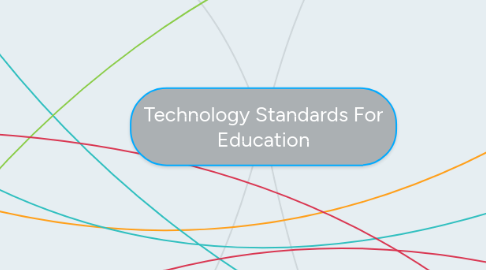Technology Standards For Education
저자: Tenasee Preiss

1. ISTE Standards For Students
1.1. 1. DIGITAL CITIZEN: Students engage in positive safe legal and ethical behaviour when using technology, including social interactions online and when using networked devices.
1.2. 2. EMPOWERED LEARNER: Students build networks and customize their learning environments in ways that support the learning process.
1.3. 3. KNOWLEDGE CONSTRUCTOR: Students build knowledge by exploring real world issues and problems, developing ideas and theories and pursuing answers and solutions.
1.4. 4. GLOBAL COLLABORATOR: Students use collaborative technologies to work with others, including peers, experts or community members to examine issues and problems from multiple viewpoints.
1.5. 5. CREATIVE COMMUNICATOR: Students communicate complex ideas clearly and effectively by creating or using a variety of digital objects such as visualizations, modes or stimulations
2. Learning and Technology Policy Framework
2.1. 1. STUDENT CENTRED LEARNING: Students use technology, online learning and digital learning to innovate: create, generate and apply new ideas.
2.2. 2. RESEARCH AND INNOVATION: Teachers, administrators, and other education professionals stay current with educational technology.
2.3. 3. PROFESSIONAL LEARNING: Digitally confident teachers, administrators and other education professionals use technology and research to design, personalize, authentic and student centred learning opportunities to meet diverse needs and interests of all students.
2.4. 4. LEARDERSHIP: Education leaders at all levels champion effective and innovative uses of technology for all schools. As a result up to date guidelines and standard uses of technology inform school authority education plans.
2.5. 5. ACCESS, INFRASTRUCTURE AND DIGITAL LEARNING ENVIRONMENTS: In Alberta's education system reliable infrastructures exist that support safe, secure efficient, interoperable and sustainable networks.
3. ISTE Standards For Teachers
3.1. 1. FACILITATE INSPIRE STUDENT LEARNING AND CREATIVITY: Teachers will engage their students in exploring real world issues and solving authentic problems using digital resources and technology
3.2. 2. DESIGN AND DEVELOP DIGITAL AGE LEARNING EXPERIENCES AD ASSESSMENTS: Teachers will customize and personalize learning activities to address students diverse learning styles, working strategies and abilities using digital tools.
3.3. 3. MODEL DIGITAL AGE WORK AND LEARNING: Teachers will communicate relevant information and ideas effectively to students, parents and peers using a variety of digital age media are formats.
3.4. 4. PROMOTE AND MODEL DIGITAL CITIZENSHIP AND RESPONSIBILITY: Teachers will advocate, model and teach safe, legal and ethical use of digital information and technology.
3.5. 5. ENGAGE IN PROFESSIONAL GROWITH F LEADERSHIP: Teachers contribute to the effectiveness, vitality and self renewal of the teaching profession and of their school and community.
4. ICT Program of Studies
4.1. 1. (C2) STUDENTS WILL SEEK ALTERNATIVE VIEWPOINTS, USING INFORMATION TECHNOLOGIES: Students will access diverse viewpoints on particular topics by using appropriate technologies.
4.2. 2. (C5) STUDENTS USE TECHNOLOGY TO AID COLLABORATION DURING INQUIRY: Students use networks to brainstorm, plan and share ideas with other group members.
4.3. 3. (F2) STUDENTS WILL UNDERSTAND THE ROLE OF TECHNOLOGY AS IT APPLIES TO SELF WORK AND SOCIETY: Students demonstrate an understanding of new and emerging communication systems.
4.4. 4. (F3) STUDENTS WILL DEMONSTRATE A MORAL AND ETHICAL APPROACH TO THE USE OF TECHNOLOGY: Students will cite sources when using copyright and/or public domain.
4.5. 5. (P4): STUDNETS WILL INTEGRATE VARIOUS APPLICATIONS: Students will use integrated software effectively and efficiently to reproduce work that incorporates data, graphics and text.


